Marketing ROI: What Junior Marketers Need to Know

Calculating marketing ROI doesn’t always require a formula.
Yes, sometimes you go deep. You track metrics like CPA and CLV while considering your marketing expenses. Other times, it can be as simple as looking at the number of leads generated from a single campaign.
Whichever way you measure it, your ROI tells you what works from a financial lens. By monitoring this metric, you make the most of your marketing budget to engage and convert customers in various touchpoints as quickly as possible.
This guide recommends a few ways to calculate ROI if you don’t know where to start, along with the metrics and terms you should know as a junior agency marketer.
Here’s what we’ll cover:
- What is Marketing Return on Investment (ROI)?
- Why it Matters to Measure Marketing ROI
- 5 Essential Marketing ROI Metrics and Terms to Get Started
- Calculating Marketing ROI: Formulas and Examples
- How to Monitor Your ROI in Real-Time
- Automate Your Marketing ROI Reporting with DashThis Today
What is Marketing Return on Investment (ROI)?
Marketing ROI is the revenue generated by your marketing efforts.
When you achieve optimal return on marketing investment, you:
- Identify the channels, campaigns, and content that drive sales
- Retain clients long-term
- Maintain or increase your budget for future campaigns
- Secure leadership buy-in, whether it’s hiring, implementing new strategies, or renewing marketing tools
- Have a competitive advantage—a biggie considering many agencies don’t report on ROI
That’s not all.
Since marketing is the heart of every business, it creates a ripple effect on sales, product, and customer success. Take a marketing-created competitor comparison guide, for instance. It helps sales development representatives (SDRs) position the product as the better choice and close the sale.
When ROI is proven, you know what works. You can quickly determine the next move in your marketing strategy, make important decisions without any guesswork, and accelerate marketing performance.
Why it Matters to Measure Marketing ROI
Tracking ROI quickly identifies your best-performing marketing assets. Specifically, you know how to:
(a) Ace your content & campaigns
Your ROI points you to the topics and themes that compel customers to act. Focus on them to create a consistent and compelling narrative that keeps your audience coming back.
(b) Identify positive ROI channels
It's really hard to stand out in a crowded market. That's why you need to invest in channels filled with your target audience today. Your ROI shows which platforms are best for your brand to stand out in a saturated market.
(c) Optimize your budget
It's not unusual for marketers who don’t track results to waste money on marketing tactics that fail. By tracking ROI and the metrics below, you identify what works best for the business and get more bang for your budget.
5 Essential Marketing ROI Metrics and Terms to Get Started
Your chosen marketing metrics give clients and leadership a complete picture of your efforts. Start with these metrics and terms.
1. Cost per acquisition (CPA)
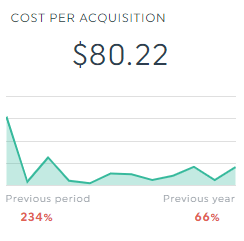
WHAT IT IS:
Cost per acquisition (CPA) is the cost paid for each acquired customer.
WHAT'S ITS RELATIONSHIP WITH MARKETING ROI:
Your CPA controls your ad spend and maximizes your campaigns for greater returns.
ONE WAY TO IMPROVE IT:
Adjust regional ad budget. PSA: focus only on target countries!
Advertising costs vary by region due to factors like competition and purchasing power. In Japan, cost per click (CPC) is 47% lower than in America, suggesting CPA is likely cheaper.
2. Return on ad spend (ROAS)

WHAT IT IS:
Return on ad spend (ROAS) is the revenue returned for each dollar spent on advertising.
WHAT'S ITS RELATIONSHIP WITH MARKETING ROI:
ROAS tracks how your ad campaigns impact the bottom line. The higher it is, the greater your ROI.
ONE WAY TO IMPROVE IT:
Segment your campaigns by intent.
For example, in your retargeting campaigns, target high-intent visitors who completed valuable actions (e.g., spent over a minute on a product page), not visitors who left after a single page view.
3. Customer lifetime value (CLV)

WHAT IT IS:
Customer lifetime value (CLV or CLTV) is the total worth of a single customer throughout their relationship with your business.
WHAT'S ITS RELATIONSHIP WITH MARKETING ROI:
CLV identifies your most profitable customers. Since retaining existing buyers costs less than acquiring new customers, you don't need to spend as much on retention efforts.
ONE WAY TO IMPROVE IT:
Cross- or upsell relevant add-ons to existing customers.
Create an upsell email sequence in your marketing automation platform that tailors emails according to customer behavior (e.g., specific purchases, predicted CLV).
4. Incremental revenue
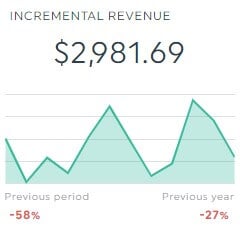
WHAT IT IS:
Incremental revenue is the additional revenue generated from new business and marketing activities.
WHAT'S ITS RELATIONSHIP WITH MARKETING ROI:
Incremental revenue calculates the profitability of new marketing initiative (e.g., entering a new market, launching a social selling program). It shows the impact of your new ventures on revenue growth, helping you decide to double down or discontinue it.
ONE WAY TO IMPROVE IT:
Increase sales without significantly raising costs. For example, get customer success to upsell high-value customers. Or, if you’re an ecommerce business, launch an abandoned cart email campaign to recover lost sales.
5. Attribution

WHAT IT IS:
Marketing attribution determines which channels, campaigns, or content influence a customer to purchase from your brand.
WHAT'S ITS RELATIONSHIP WITH MARKETING ROI:
Attribution is insanely tricky. But when done well, you understand the impact of every channel, forecast results accurately, and know where to set your budget accordingly. Over time, you drive better results and ROI.
ONE WAY TO IMPROVE IT:
There are multiple attribution types: first-touch, last-touch, and multi-touch.
The problem with touch-based attribution is its inability to measure offline channels.
A better alternative is using tools like Paramark to measure the incremental impact of individual channels. These platforms integrate not only your campaign data, but also marketing mix modeling and incrementality testing for a hyper-detailed understanding of your ROI.
If this is too complex for your needs, consider using DashThis. It automatically gathers your data across multiple marketing platforms into one straightforward report. Start your free 15-day trial today.
Calculating Marketing ROI: Formulas and Examples
There are mainly two ways to measure marketing ROI.
Either measure it using a formula. Or evaluate it by the goal(s) you achieved.
Here's a closer look.
(i) ROI CALCULATION
The most common formula to calculate marketing ROI, whether for a single marketing campaign or overall efforts, is:
[(Revenue – Total marketing cost) / Total marketing cost] x 100%
Let's illustrate this with an example.
Suppose a bootstrapped startup generated $40,000 in software sales from $15,000 in marketing spend. The marketing ROI would be:
[(40,000 - 15,000) / 15,000] x 100% = 166.7%
To gauge if it’s a good marketing ROI, compare it with industry benchmarks or your previous campaign's performance.

[Data via DashThis] Specify your time period and compare different campaign performances in a single tab
Note that some advertising platforms track return on ad spend (ROAS), not ROI. The formula for this metric is:
(Revenue – Ad Cost) / Ad cost
(ii) GOALS ACHIEVED
Not all top executives measure ROI by a percentage. Some CMOs focus on the objectives below:
- Number of leads or sales generated from a channel
- Break-even time
- Sales generation time
Discuss with the client what needs to happen for them to get a positive ROI. Their answer will determine the best way to communicate it.
How to Monitor Your ROI in Real-Time
Agency marketers often spend hours weekly gathering campaign numbers for clients.
If you're working with seven clients with five marketing channels each, that's over 10 hours of non-billable work weekly.
Consider delegating these manual tasks to automated reporting tools like DashThis.
Automatically gather your data across multiple marketing platforms into one beautiful report. Agencies tracking ROI automatically on DashThis enjoy:
(i) Native integrations with major players like Google Analytics 4, Facebook Ads, and MailChimp. With every campaign’s performance in one place, you can quickly distill insights, narrow down potential issues, and make data-driven decisions.
(iv) Pre-filled metrics like CPA and ROAS. Click any metric once, and DashThis automatically grabs and transforms it into a visually appealing graph or chart.
(v) Unlimited accounts, data sources, and users, regardless of your plan
(vi) Multiple sharing options, including automatic email dispatch. Your data updates daily for access to the latest results
But enough about the features.
Let's explore how it works:
- Select a report template
- Connect your favorite marketing channels with DashThis
- Choose your metrics in Preset Widgets
Wait a few seconds while DashThis gathers your chosen metrics automatically. Then, drag and drop them in an easy-to-understand format. Here’s how it might look for a brand investing in PPC and content marketing.
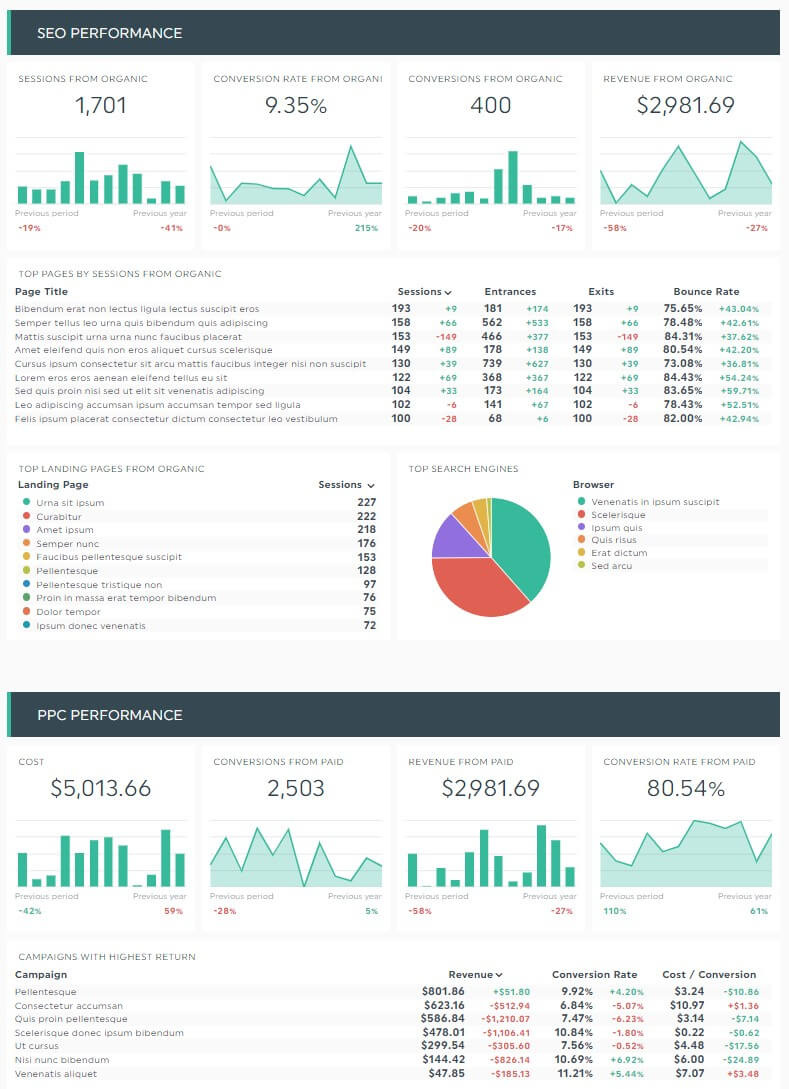
Customize your marketing ROI dashboard based on the client's needs. For example, you can add a comment in the report to:
- Summarize your brand awareness campaign for time-strapped clients
- Illustrate how the latest landing page contributed to this month’s sales growth
- Persuade clients to extend a successful short-term social media series to drive more customers and positive ROI
Click Static Widget > Comment to make your case.

Click Save.
Pro tip: Use our Notes widget to provide context for specific metrics (e.g., increase in no. of subscribers in email marketing likely due to higher site traffic). Or define common marketing ROI metrics if you’re working with a client with zero marketing expertise (e.g., CVR = conversion rate).
Once you’re done, schedule an automatic email dispatch to clients and the marketing team:
- Hover over the Sharing Options icon in the top right
- Click Share by Email
- Set the dashboard period and frequency
- Add an optional note
- Click Schedule
Automatically send your report according to your preferred schedule.
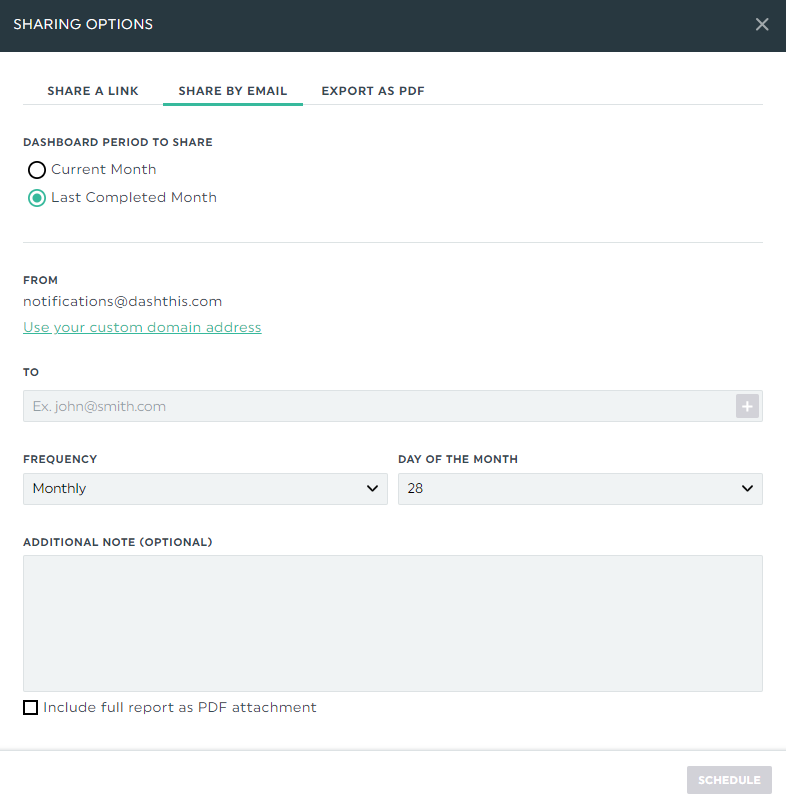
Alternatively, share your marketing ROI report via a URL link.
Start your free 15-day trial today to automate your ROI reporting.
Free digital marketing report template
Identify positive ROI channels to stand out in a competitive market.
Note the digital marketing reporting below. You can tell right away that LinkedIn is your best channel despite the fluctuating trend since February. Based on this data, you could implement a new strategy—like having all SDRs engage in social selling.
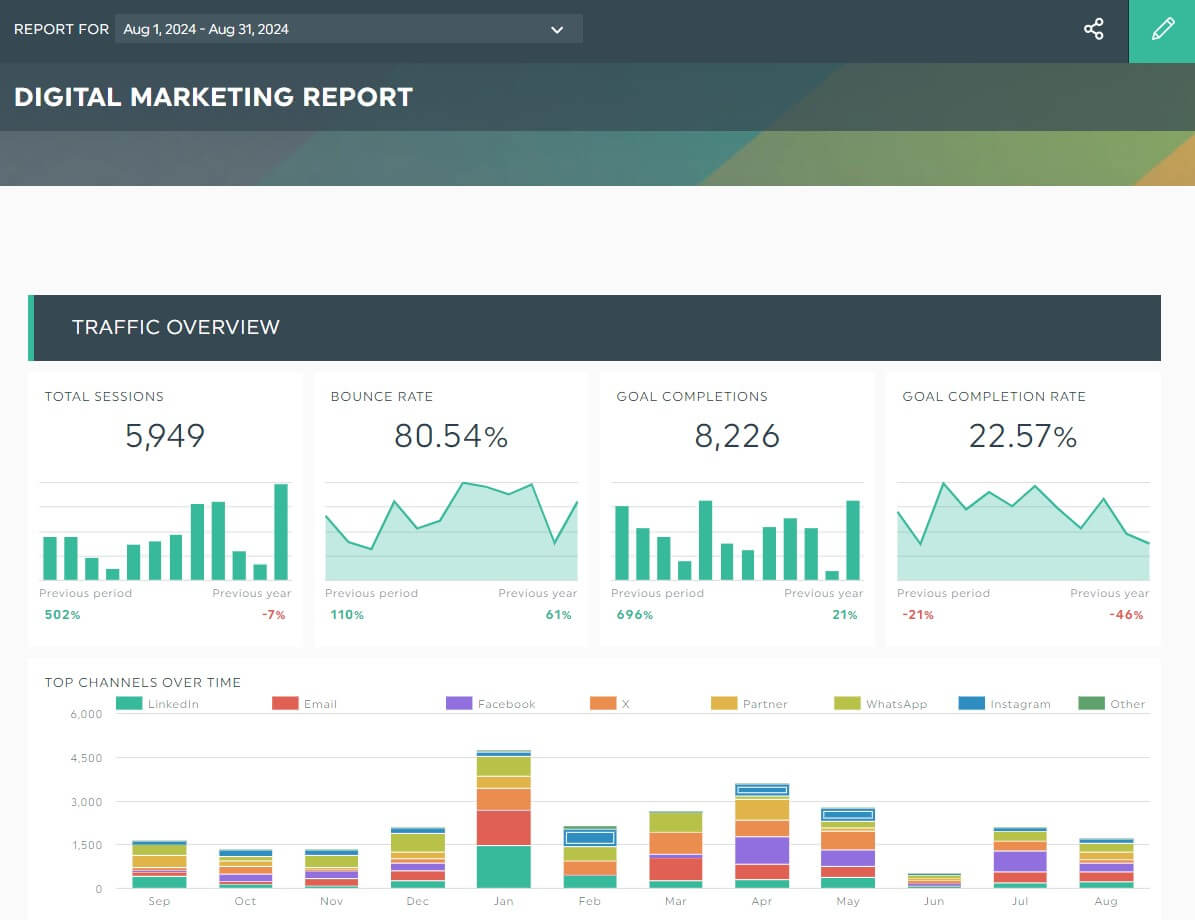
Grab this free digital marketing report template with your own data!
Automate Your Marketing ROI Reporting with DashThis Today
Discuss with clients what needs to happen for a positive ROI. Their response will determine the best way to communicate their returns. The monitor the metrics above for a clearer picture of your ROI.
And while you’re at it, automate your reporting with a tool like DashThis.
Automatically gather your data from multiple platforms into one report using the easiest reporting tool. Start your free 15-day trial to automate your ROI reporting today.
Ready to measure your marketing ROI?
Read More
Don’t miss out!
Automate your reports!
Bring all your marketing data into one automated report.
Try dashthis for free

